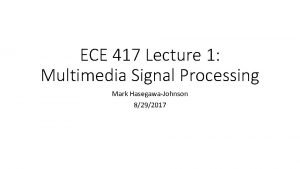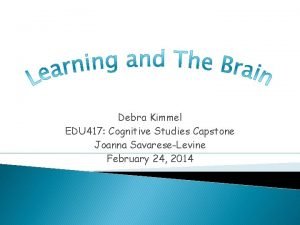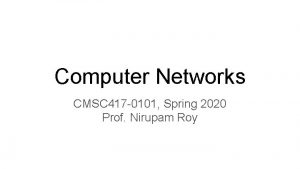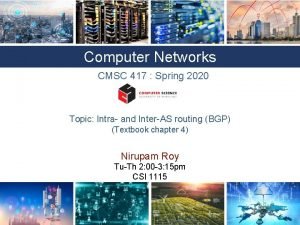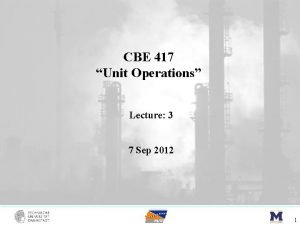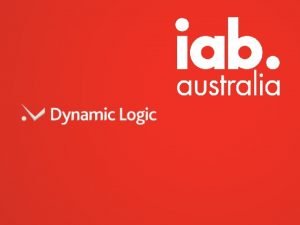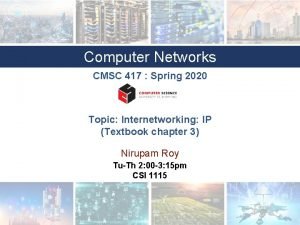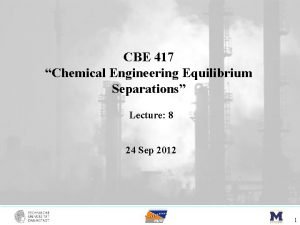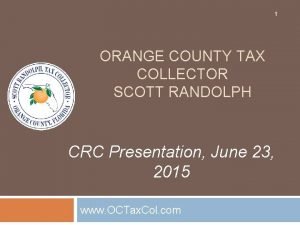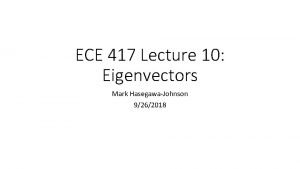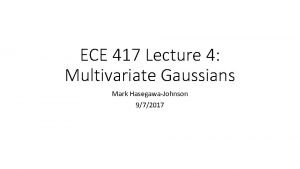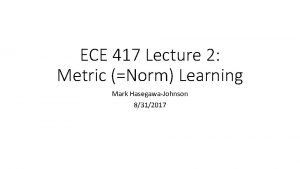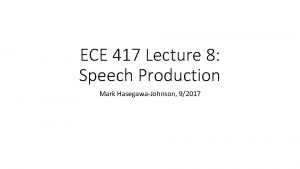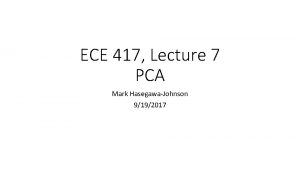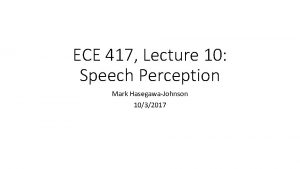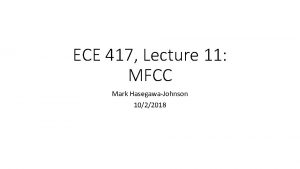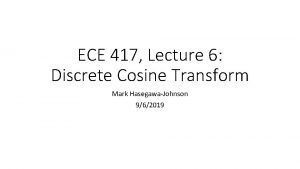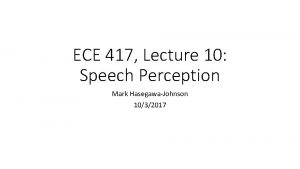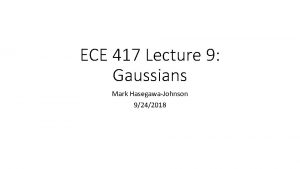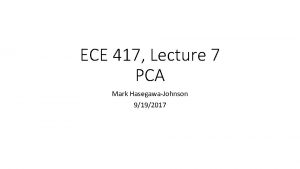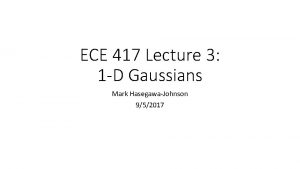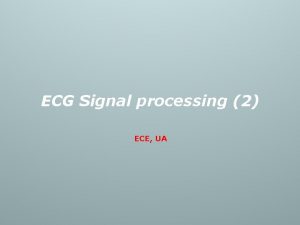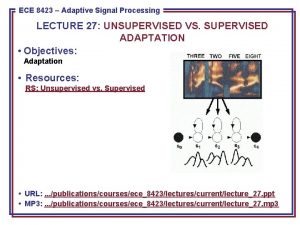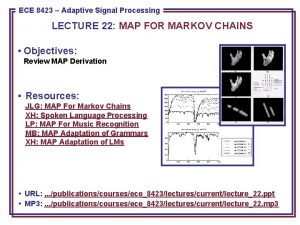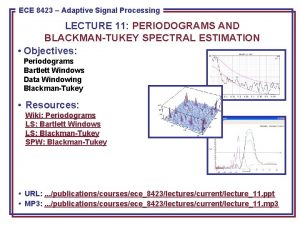ECE 417 Lecture 1 Multimedia Signal Processing Mark























- Slides: 23

ECE 417 Lecture 1: Multimedia Signal Processing Mark Hasegawa-Johnson 8/29/2017

Today’s Lecture • Syllabus • Overview of what we’ll learn this semester • Review of important linear algebra concepts, part one • Sample problem

Syllabus • Go read the syllabus: http: //courses. engr. Illinois. edu/ece 417/

Overview of what we’ll learn this semester • What is multimedia? • What is processing? • The basic architecture: encoder, embedder, aligner, decoder • Parametric learning: categories of methods, types of parameters that you can learn from data

What is multimedia? • Audio, Video, and Images • Defining feature #1: very big • • Speech audio: 16000 samples/second Multimedia audio: 44100 samples/second (often downsampled to 22050!) Image: 6 M pixels ~ 2000 x 3000 (often downsampled to 224 x 224) Video: 640 x 480 pixels/image, 30 frames/second = 9, 216, 000 real numbers per second • Why “very big” matters: you can’t train a neural net to observe a whole image • Rule of 5: there must be 5 training examples per trainable parameter • Two-layer neural net with 1024 hidden nodes, 6 M inputs has 1024*6000000 trainable parameters = 6 billion trainable parameters • With 6 billion trainable parameters, you need 30 billion training examples • Result: we need some trick to reduce the number of parameters • This semester is all about finding tricks that work (much better)

What is Multimedia: Defining Feature #2 • Defining feature #2: variable input dimension • Image classification, e. g. , imagenet: we like to downsample every image to 224 x 224 first, then train a NN with 224*224=50176 inputs • Audio speech recognition: no can do • Why? • Solution: streaming methods • “Recognition” instead of “Classification” --- variable number of inputs, variable number of outputs

Processing = convert from one type of signal to another Image Video Audio Text (variablelength sequence of symbols) Metadata (tags drawn from predefined set) Image X Motion prediction Animation Spoken captioning Automatic captioning Object recognition Face recognition Video Heat map Frame capture Summarization Shot boundary detection X Audio Spectrogram(S TFT) STFT Avatar animation Text Metadata Lipreading/ Speechreading Audiovisual speech recognition Summarization X Audiovisual speech Speech synthesis Search Automatic speech recognition Music genre Emotion/sentimen ts Speaker ID X Sentiment X

Basic Multimedia Architecture: EEAD Decoder (compute outputs) n=Output Aligner Timescale (time alignment) Embedder (compute state) Encoder (compute features) t=Input Timescale

Parametric Learning •

Types of Parametric Learning • Metric Learning/Feature Learning (MP 1): Learn to convert input features into some new feature set that better matches human perception • Classifier Learning (MP 2, MP 3): Learn to classify the input. • Bayesian Learning (MP 4, MP 5): Learn to estimate how likely the input is, given some assumed class label. • Deep learning (MP 6, MP 7): Combines feature learning and classifier learning. Each layer computes features that are used by the next layer up.

Basics of Linear Algebra • Vector Space • Banach Space, Norm • Hilbert Space, Inner Product • Linear Transform • Affine Transform

Vector Space A vector space is a set, closed under addition, that satisfies: • Addition commutativity • Addition associativity • Addition identity element • Addition inverse • Compatibility of scalar and field multiplication • Multiplication identity element • Distribution of multiplication over vector addition • Distribution of multiplication over field addition


Banach space, Norm A Banach space is a vector space with a norm. A norm is: • Non-negative • Positive definite • Absolute homogeneous • Satisfies the triangle inequality


Inner Product Space An inner product space is a Banach space with a dot product (a. k. a. inner product). An inner product is a function of two vectors that satisfies: • Conjugate commutative • Linear in its first argument • Positive definite


Linear Transform A linear transform converts one vector space into another, with the following rules: • Homogeneous • Satisfies superposition A linear transform is written as a matrix multiplication, y=Wx


Affine Transform An affine transform is a linear transform plus an offset. It’s usually written as y=Wx+b, where Wx is the linear part, and b is the offset.


Example Problem •

How many trainable parameters? •
 Ece 417
Ece 417 Ece 417
Ece 417 Southwest airlines route map
Southwest airlines route map 417 studies
417 studies Cmsc 417
Cmsc 417 Cmsc417
Cmsc417 Department of transportation
Department of transportation Cmsc 417
Cmsc 417 Cbe 417
Cbe 417 Campaign_id:417
Campaign_id:417 Internetwork
Internetwork Stripping rectifying section
Stripping rectifying section Tag agency university
Tag agency university 01:640:244 lecture notes - lecture 15: plat, idah, farad
01:640:244 lecture notes - lecture 15: plat, idah, farad Baseband signal and bandpass signal
Baseband signal and bandpass signal Baseband signal and bandpass signal
Baseband signal and bandpass signal Digital signal as a composite analog signal
Digital signal as a composite analog signal What is the product of an even signal and odd signal
What is the product of an even signal and odd signal Multimedia becomes interactive multimedia when
Multimedia becomes interactive multimedia when A multimedia project is identified as non-linear when
A multimedia project is identified as non-linear when Linear and nonlinear multimedia
Linear and nonlinear multimedia Esa multimedia.esa.int./multimedia/virtual-tour-iss
Esa multimedia.esa.int./multimedia/virtual-tour-iss Natural language processing nlp - theory lecture
Natural language processing nlp - theory lecture Image processing lecture notes
Image processing lecture notes
